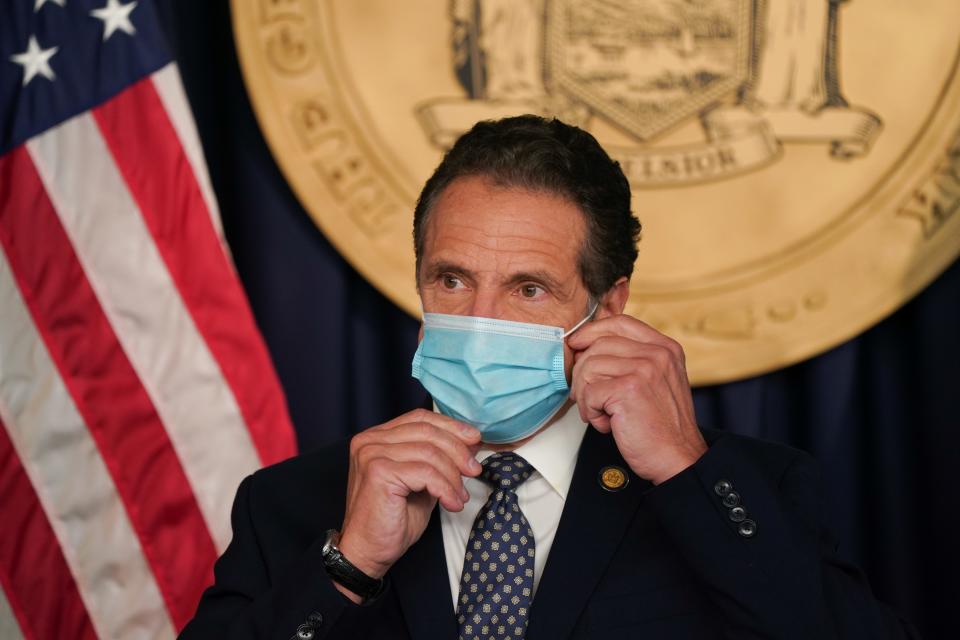Traveling to New York? You will need to take a COVID test first. Here are the new changes
ALBANY - New York is scrapping its weekly list of states from where visitors had to quarantine and instead implementing a new COVID-19 testing system for all travelers outside contiguous states.
Gov. Andrew Cuomo announced the change Saturday, saying a rigorous testing standard is a better way to control the virus' spread in New York, reports the Democrat & Chronicle, a USA TODAY Network publication.
Almost all states were on the state's 14-day quarantine list, making its weekly metrics to determine who met the criteria a fluid system. Even New York itself was trending toward making its own list on Tuesday, when it was next due to be updated.
"Given the changing facts, we’re coming up with a new program," Cuomo said on a conference call with reporters. "And all the experts suggest we shift to a testing system, and that’s what we are going to do."
Here's the new policy
Visiting from a non-contiguous state: If a person wants to visit New York or if a resident left New York for more than 24 hours and wants to return, they must first take a COVID test that proves they are negative within three days prior to their arrival.
Arriving in New York: When a visitor or resident returns to the state, even after a negative test before arrival, they have to quarantine for three days. Then, on the fourth day, they need to take another COVID test. If it's negative, they can be released from quarantine. If not, they have to fulfill a 14-day quarantine.
Leaving New York for less than 24 hours: If a person left New York to a non-border state for less than 24 hours, the traveler would not need to take a test before a return. But he or she would need to take a COVID test after four days.
Dealing with border states: For Connecticut, New Jersey, Pennsylvania, Massachusetts and Vermont, the testing requirements do not apply because how often people might travel between the states for work or personal trips, Cuomo said.
What if test results are not back in time? Cuomo's office the change essentially creates an "opt out" program when you can get negative test results. In other words, a person would need to stay in quarantine in New York until their results come back negative.

Cuomo said people traveling from out of state for more than 24 hours would essentially have two tests within seven days that should help detect most positive cases.
"The mandatory quarantine is actually three days upon arrival, you can get a test on the fourth day. The test says you’re negative, that’s that," Cuomo explained.
"So you will have a test within three days of arrival, that says your negative, a test four days after arrival that says you’re negative. Four days plus three days is seven days, and that is basically by all probability the incubation period."
Previously, New York had applied the 14-day requirement to any traveler arriving from states that had at least 10 average daily new cases per 100,000 residents over the prior week, or at least 10% of COVID-19 tests returned positive over the prior week.
The latest list last Tuesday had required travelers from 41 states and territories to undergo a 14-day self-quarantine upon arrival to New York. The list included the nation's three most-populous states in the country — California, Florida and Texas -- but exempted border states New Jersey, Connecticut, Pennsylvania and Massachusetts.
New York itself appeared to be right at the threshold for making the list Friday and Saturday.
The state's rate based on 2019 Census population estimates was at 10 average daily cases per 100,000 residents on Saturday after reporting 2,049 cases from the day before.
Cuomo's administration, meanwhile, maintained the state was actually at 9.99 average daily cases on Friday and 9.8 on Saturday.
The state uses a population figure of 19.54 million residents to calculate the figure, which was the Census Bureau's 5-year population estimate released in 2018 and slightly higher than the bureau's one-year 2019 estimate. That figure, which the state has been using since the start of the pandemic, bumps the state slightly below the threshold.
Cuomo said the goal of the new travel policy is to keep New York's infection rate to among the lowest in the nation.
At a 1.5% positivity rate Friday, which includes the state's dozen or so hot spots, New York ranked behind only Maine and Vermont as having the lowest rates in the nation, Cuomo said.
That's after the state had the most deaths and highest infection rates in the nation last spring as the virus struck the Northeast first before it spread across the U.S.
New York, the nation's fourth most populous state, hit more than 500,000 positive cases on Thursday, a mark the three other largest states, California, Texas and Florida, already surpassed.
New York has the capacity to expand its testing, Cuomo said. It tested 136,000 people on Friday.
This article originally appeared on New York State Team: Traveling to NY? You will need a COVID test first

